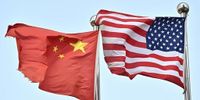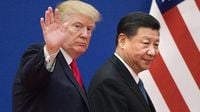In a dramatic escalation of the ongoing U.S.-China technology and trade standoff, the Trump administration is weighing sweeping new export restrictions targeting products made with U.S. software, particularly those destined for China. The proposed measures, reported by multiple outlets including Reuters and Eurasia Business News on October 22, 2025, would mark a significant expansion of the foreign direct product rule (FDPR), which currently allows the United States to regulate foreign-made goods that incorporate American technology—even if those goods are manufactured outside U.S. borders.
The heart of the new proposal is clear: to curb China’s rapid advancement in the semiconductor and artificial intelligence sectors by choking off access not just to American hardware, but to the critical software that underpins chip design and production worldwide. According to Eurasia Business News, the move is part of a broader U.S. strategy to maintain technological superiority and limit China’s progress in these high-stakes industries. The FDPR expansion would mean that any product containing U.S. software—think everything from laptops to jet engines—could fall under the new restrictions.
U.S. Treasury Secretary Scott Bessent, speaking just days before a scheduled meeting with Chinese Vice Premier He Lifeng, summed up the administration’s stance succinctly: “Everything is on the table,” Bessent told reporters at the White House on October 22, when asked specifically about software export curbs. He added that if the U.S. moves forward, it would coordinate closely with its G7 allies to ensure a unified approach. “If these export controls—whether it’s software, engines or other things—happen, it will likely be in coordination with our G7 allies,” Bessent said, according to Reuters.
The timing of these deliberations is no coincidence. The latest U.S. steps come as China has imposed its own export controls on rare earth elements and related technologies—materials critical for the global production of electronics, defense systems, and electric vehicles. These tit-for-tat measures have set the stage for what many analysts are calling a new phase in the U.S.-China “trade war,” one centered not just on tariffs but on the very building blocks of modern technology.
The stakes are enormous. “Everything imaginable is made with U.S. software,” one source told Reuters, highlighting the potential breadth of the proposed restrictions. The plan, if fully implemented, could disrupt global trade in technology products and reverberate through supply chains spanning continents. Emily Kilcrease, a former U.S. trade official now at the Center for a New American Security, commented, “Software is a natural point of leverage for the U.S. Still, such controls would be extraordinarily difficult to implement and would lead to blowback for U.S. industry.”
While some in the administration reportedly favor a more measured approach, the White House has not shied away from bold rhetoric. President Donald Trump, responding to China’s rare earth restrictions on October 11, announced that the U.S. would impose a 100% tariff on all imports from China, “over and above any tariff that they are currently paying,” effective November 1 or sooner. “Starting November 1st, 2025 (or sooner, depending on any further actions or changes taken by China), the United States of America will impose a Tariff of 100% on China, over and above any Tariff that they are currently paying,” Trump posted on social media. He further declared that the U.S. would implement export controls on “any and all critical software” produced by American firms.
China, for its part, has responded with a mix of defiance and warning. A spokesperson for the Chinese embassy, quoted by Reuters, stated that China “opposes the U.S. imposing unilateral long-arm jurisdiction measures” and vowed to “take resolute measures to protect its legitimate rights and interests” if the U.S. proceeds. The Chinese government has also expanded its own export controls on rare earths and related technologies, signaling that it is prepared to match U.S. actions step for step.
President Trump has not minced words in describing China’s export restrictions. He called Beijing’s actions “extraordinarily aggressive” and “a moral disgrace in dealing with other Nations.” Trump went on to say, “It is absolutely unheard of in International Trade… It is impossible to believe that China would have taken such an action, but they have, and the rest is History.” He also emphasized America’s own strategic positions in rare earths and critical materials, declaring, “There is no way that China should be allowed to hold the World ‘captive,’ but that seems to have been their plan for quite some time… But the U.S. has Monopoly positions also… UNTIL NOW!”
The proposed software-based export controls would echo measures imposed by the Biden administration on Russia following its 2022 invasion of Ukraine. Those rules restricted exports to Russia of items made globally using U.S. technology or software. The current U.S. tariffs on Chinese goods already range from approximately 30-40%, with steel facing a 50% tariff and consumer products around 7.5%. The new 100% tariff, if enacted, could push some rates as high as 130-145%, according to Eurasia Business News. Chinese imports currently face U.S. tariffs around 55%, which could soar to 155% if Trump follows through on his threatened hike.
Even as the administration weighs these dramatic moves, there is recognition of the risks involved. The potential for blowback on U.S. industry is real, as American companies are deeply integrated into global supply chains. The White House and Commerce Department have so far declined to comment publicly on the details of the proposed restrictions, perhaps reflecting the internal debate over how far to push the confrontation.
The financial markets have not been immune to the uncertainty. U.S. stock indexes dipped following the Reuters report on October 22, with the S&P 500 closing down 0.5% and the Nasdaq about 1% lower. The economic fallout from a full-scale technology decoupling between the world’s two largest economies could be far-reaching, affecting everything from consumer electronics to the automotive and defense sectors.
Diplomatic efforts continue in parallel with the economic sparring. U.S. Treasury Secretary Bessent is expected to meet with Chinese Vice Premier He Lifeng in Malaysia this week, ahead of a planned summit between President Trump and Chinese President Xi Jinping in South Korea later in October. Both sides have signaled a desire to de-escalate tensions, but neither appears willing to back down on core issues of technology and trade.
As the world watches, the outcome of these talks—and the fate of the proposed export controls—could reshape the global technology landscape for years to come. With each side digging in, the prospect of a technology Cold War seems less like a metaphor and more like a reality inching closer by the day.






